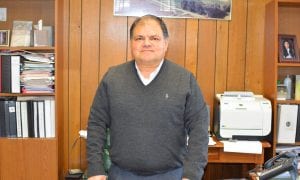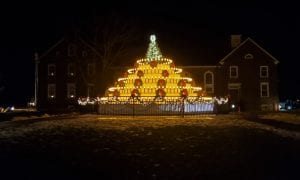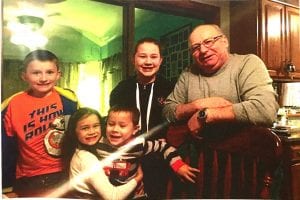
Kazimierz ‘Kaz’ Trzepacz, far right, is seen in this family photo. (Photo courtesy of the Trzepacz family)
WESTFIELD- On New Year’s Eve, hundreds of Westfield residents gathered at Amelia Park to for the city’s first ever ‘First Night’ celebration in honor of the Westfield 350th anniversary. There was a parade, food, and activities for kids throughout the night. Of course, no New Year’s Eve party can go without a ball drop to cap off the night.
Harry Rock, President of the Friends of the Westfield 350th, asked Columbia Manufacturing if they could construct a ‘ball’ that would drop at the end of the night. Ali Salehi, President of the Westfield based manufacturing company, tasked Kazimierz ‘Kaz’ Trzepacz with creating the sculpture. Rather than create a traditional ball like one would see in Times Square, Rock asked Columbia to create a welded sculpture of an old-style bicycle, for which Columbia Manufacturing is famous for pioneering.
“I said, ‘Kaz, make me this,’” said Salehi while pointing to a drawing of the bike on a piece of draft paper, “This is all I gave him.”
This project began in the Spring and was finished in September. It was no small task despite Kaz’s three decades of experience. The full structure was about twenty feet wide and ten feet tall when it was finished.
“Kaz made this thing from scratch,” said Salehi, “He bent this wheel. It’s six feet in diameter. He hand welded every spoke piece by piece to replicate an 1877 high wheeler bicycle.”
Much of the bike was made from more than 200 pieces of one-inch steel tubing that Kaz bent and welded himself. He was a known handyman, to put it lightly. Kaz never received a formal education in engineering, welding, or construction, his talents simply came naturally to him.
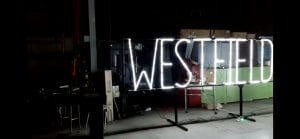
The sign as it stood in the Columbia Manufacturing floor. The lights consisted of hundreds of LED’s covering the surface of the bike and sign. (Photo submitted)
“He was just an all-around guy,” said his wife, Mary, “He was a plumber, electrician, mechanic. He could fix anything and when he did, it was fixed for life.”
Kaz brought his talents from Poland to the U.S. on June 27th, 1975. He had lived in Poland since he was born just a few years after the devastation of World War Two. He had worked at Columbia for 35 years before retiring in 2016. Despite his retirement, Salehi told him that he could come to the factory any time he wanted and work on whatever he wanted.
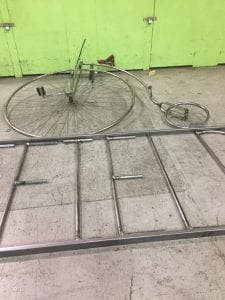
The bike as it lay on the Columbia Manufacturing factory floor. Kaz had welded each bar and tube together. He also bent the wheels of the bike himself. Each piece of tubing is one inch thick. (Photo submitted)
By mid-November the mount, lighting, and overall structure of the bike were complete. In early December, Kaz visited Salehi’s office while he was working on another project. He said he was not feeling well and that he would be going home for the day. Salehi let him go, but not before reminding him of the Christmas luncheon that would take place that Friday.
“That Friday morning at 7:30 my phone rang from Kaz’s number. It was very unusual for him to call me on a Friday morning,” said Salehi, “It was not Kaz, but rather his son. Kaz had passed away the night before.”
Kaz never got to see his work be displayed for the First Night celebration. Salehi asked Kaz’s family to be at the ceremony. He wanted to make sure his work was appropriately recognized. Salehi was given the honors of plugging in the installation. However, because of the rain, the bike did not ‘drop’ as was originally planned.
“He was the most talented, most dedicated employee that anybody could have asked for,” said Salehi, “All you had to do was tell him the vision of the project, and then he would make it. He was a natural artist.”

The bike after it had been lit up at Amelia Park during the First Night celebration. The lights on the wheel are programmed to look as though the wheel is spinning. Paul Asselin of Elm Electric did much of the electrical work after Kaz had finished building the bike. (Photo submitted)
Salehi said that when The Westfield 350th Celebration is done with the bicycle, it may be donated to a museum with a plaque in memory of Kaz. He did leave the door open that the structure could be used in future First Night celebrations as well.
One way or another, Salehi is committed to ensuring that the legacy of Kazimierz Trzepacz is forever remember in the City of Westfield. Kaz is survived by his wife, Mary, their two sons Michael and Edward, their four Grandchildren Emerson, Gavin, Saige, and Lucas, and his siblings Henry and Christina.
Mary remembers her husband as the naturally skilled engineer that he was known to be at Columbia. She emphasized that there was next to nothing he could not make or fix if he had the right materials.
“He didn’t need blueprints,” said Mary, “you could tell him what needed fixing, and he would go to the garage and think about it and it would be done.”



